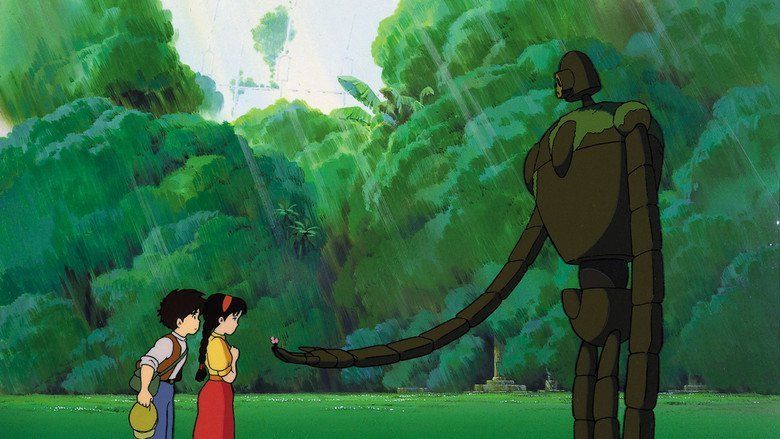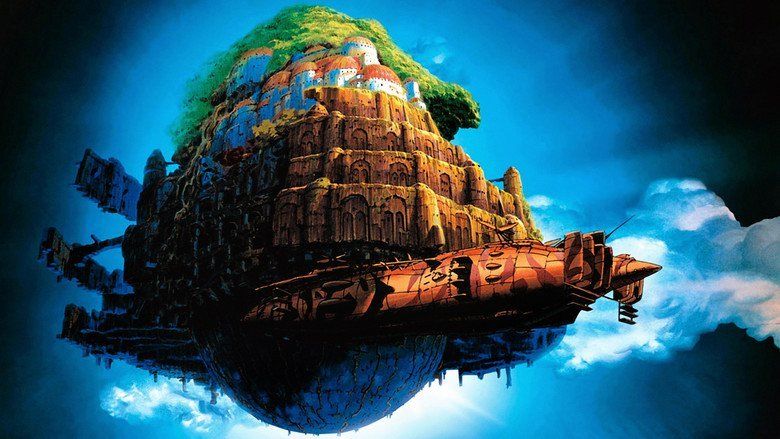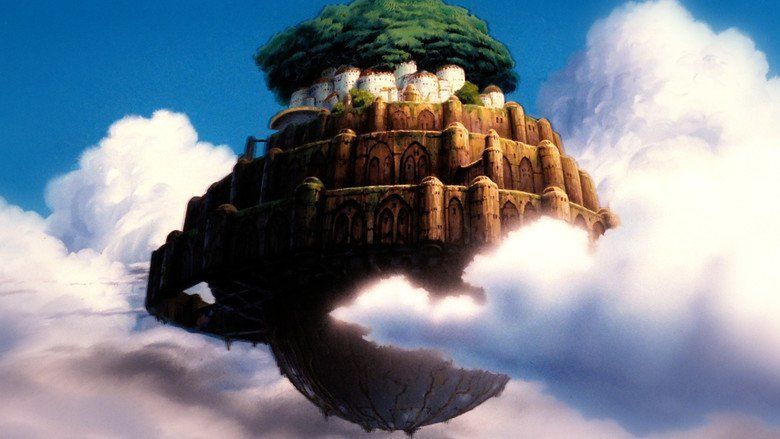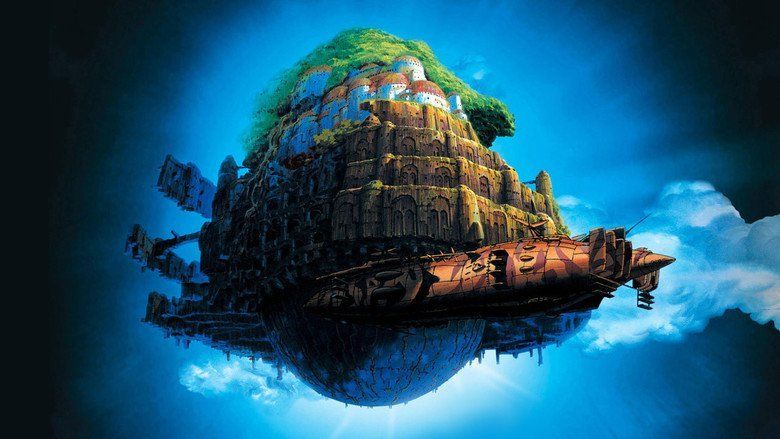Castle in the Sky
9.4 /10 2 Votes
95% Rotten Tomatoes Genre Animation, Adventure, Family | 8.1/10 IMDb Duration Country Japan | |||||||||||||||||||||||||||||||||
 | ||||||||||||||||||||||||||||||||||
Release date August 2, 1986 (1986-08-02) Cast (Sheeta (voice)), (Pazu (voice)), (Muska (voice)), Kotoe Hatsui (Dola), Fujio Tokita (Uncle Pomme), Ichir? Nagai (Shogun Mouro)Similar movies | ||||||||||||||||||||||||||||||||||
Castle in the Sky (Japanese: 天空の城ラピュタ, Hepburn: Tenkū no Shiro Rapyuta) (known as Laputa: Castle in the Sky in the United Kingdom and Australia) is a 1986 Japanese animated adventure film written and directed by Hayao Miyazaki that marked the cinematic feature debut of Studio Ghibli. It follows the adventures of a young boy and girl attempting to keep a magic crystal from a group of military agents, while searching for a legendary floating castle. The film was distributed by Toei Kabushiki Kaisha. Laputa: Castle in the Sky won the Animage Anime Grand Prix in 1986.
Contents
- Plot
- Soundtrack
- Setting
- Influences
- Distribution and reception
- Awards
- Title
- Differences between versions
- References

Plot

An airship carrying Sheeta, a girl who has been abducted by government agent Muska, is attacked by Captain Dola and her air pirate sons who are in search of Sheeta's crystal amulet. In the resulting struggle, Sheeta falls from the airship but her descent is slowed by a mysterious power within the amulet. She safely lands in a small mining town where she is discovered by a boy named Pazu, who takes her into his home to recover. Pazu tells her of a mysterious floating island named Laputa which is visible in a picture taken by his father. Later, they are pursued by Dola's pirates, and then by Muska's soldiers. Eventually, the two fall into an abandoned mine, where they encounter the local eccentric Uncle Pomme, who informs them that Sheeta's amulet is made of 'volucite' crystal ('Aetherium' in the American release), a material used to keep Laputa and the other flying cities aloft.

Upon leaving the mines, Sheeta tells Pazu that her full name is 'Lucita Toel Ul Laputa'. They are then captured by Muska and taken to the fortress of Tedis, where Pazu is imprisoned in a dungeon tower while Sheeta is imprisoned in a more lavish room. Muska shows Sheeta a dormant Laputan robot and reveals his knowledge of her secret name, which he interprets to be that of the Laputan royal line. Muska then threatens Pazu's life to obtain Sheeta's cooperation. For his own safety, Sheeta orders Pazu to leave and Muska offers him money to leave and forget about Laputa.

A distraught Pazu returns home, where he is ambushed by Dola's sons. After hearing Pazu out, Dola and her sons prepare to intercept and capture the crystal, allowing Pazu to join them. As preparations proceed, Sheeta recites an apotropaic verse and unexpectedly activates the amulet and the robot, which follows Sheeta, destroying the fortress along the way until it is overcome by the military's airship Goliath. Pazu arrives and rescues Sheeta, but Muska obtains the amulet. The pirates, accompanied by Pazu and Sheeta, return to their airship, Tiger Moth. They pursue the Goliath, which is following directions indicated by Sheeta's amulet to locate Laputa. Both airships arrive at Laputa on the following day, with the Tiger Moth having been shot down by Goliath. The two children, separated from Dola's pirates, discover the city to be ruined and overgrown.

Dola's pirates are captured and Muska's soldiers plunder the city's treasures. Upon gaining entrance to the city's central sphere, a vast repository for all of Laputa's scientific knowledge, Muska captures Sheeta and his agents open fire upon Pazu, who escapes and frees Dola's pirates. In the center of Laputa, containing the immense 'volucite' crystal and keeping the city aloft, Muska identifies himself as "Romuska Palo Ul Laputa", a member of another royal line, and uses Sheeta's crystal to access the advanced Laputan technology. He betrays his own soldiers and destroys the Goliath. During the mayhem, Sheeta retrieves the crystal amulet and flees, but Muska pursues her. Encountering Pazu, Sheeta gives the amulet to him through a gap in the wall and is cornered by Muska in Laputa's throne room.

During her confrontation with Muska, Sheeta realizes and explains that the people of Laputa left the castle because they realized that man was meant to live on earth and not in the sky. Muska refuses her arguments, shoots off her braids and threatens to kill her unless the crystal amulet is given to him. Pazu requests to be allowed to talk with Sheeta; Muska grants them three minutes. Sheeta and Pazu recite a "Spell of Destruction", destroying much of the city, and Muska falls to his death. After surviving the collapse, Pazu and Sheeta reunite with Dola and her pirates and leave Laputa behind. When they part with the pirates, Pazu flies Sheeta home as he had promised her, to start a new life together.
During the end credits, the remnants of Laputa float in orbit, maintained by the volucite crystal embedded in the roots of the central tree.
Soundtrack
All compositions by Joe Hisaishi.
- "The Girl Who Fell from the Sky" – 2:27
- "Morning in the Slag Ravine" – 3:04
- "A Fun Brawl (Pursuit)" – 4:27
- "Memories of Gondoa" – 2:46
- "Discouraged Pazu" – 1:46
- "Robot Soldier (Resurrection/Rescue)" – 2:34
- "Carrying You" – 2:02 (Chorus: Suginami Children's Choir)
- "Sheeta's Decision" – 2:05
- "On the Tiger Moth" – 2:32
- "An Omen to Ruin" – 2:18
- "The Sea of Cloud Under the Moonlight" – 2:33
- "Laputa: Castle in the Sky" – 4:36
- "The Collapse of Laputa" – 2:00 (Chorus: Suginami Children's Choir)
- "Carrying You" – 4:07 (sung by Azumi Inoue)
Setting
The world in which the story takes place is clearly Earth, but apparently in an alternate history. None of the place names match real-life geography. The airships appear to use buoyant gas, but are different in appearance than actual dirigibles. The pirate flaptors and military planes do not resemble actual craft. The movie takes place sometime between 1868 and 1900, as the photograph of Laputa inside Pazu's house, taken by his father, is dated "1868. 7," which evidently means "July 1868".
Influences
The name 'Laputa' is derived from Jonathan Swift's novel Gulliver's Travels, wherein Swift's Laputa is also a flying island controlled by its citizens. Anthony Lioi feels that Miyazaki's Laputa: Castle in the Sky is similar to Swift's Laputa, where the technological superiority of the castle in the sky is used for political ends.
Laputa is credited by Colonel Muska with having informed Biblical and Hindu legends — thus tying the world of Laputa to our Earth (and to western European civilization) — as do the medieval castle architecture on the ground; the Gothic and half-timbered buildings in the village near the fort; the Welsh mining-town architecture, clothing, and ground vehicles of Pazu's homeland; and the Victorian ambiance of the pirate ship. The anime also features the use of cuneiform script on Laputa's interactive panels and tombstones; and makes references to the Hindu epic Ramayana, including "Indra's arrow", while the name Sheeta may be a related to Sita, the female lead in the Ramayana.
Some of the architecture seen in the film was inspired by a Welsh mining town. Miyazaki first visited Wales in 1984 and witnessed the miners' strike firsthand. He returned to the country in 1986 to prepare for Laputa, which he said reflected his Welsh experience: "I was in Wales just after the miners' strike. I really admired the way the miners' unions fought to the very end for their jobs and communities, and I wanted to reflect the strength of those communities in my film." Miyazaki told The Guardian, "I admired those men, I admired the way they battled to save their way of life, just as the coal miners in Japan did. Many people of my generation see the miners as a symbol; a dying breed of fighting men. Now they are gone."
Except for the technology of Laputa itself, the technologies (especially the flying machines) are an example of the retrofuturistic genre of steampunk.
Distribution and reception
In the late 1980s, an English dubbed version, produced by Magnum Video Tape and Dubbing for international Japan Airlines flights at the request of Tokuma Shoten, was briefly screened in the United States by Streamline Pictures. Carl Macek, the head of Streamline, was disappointed with this dub, deeming it "adequate, but clumsy". Following this, Tokuma allowed Streamline to dub their future acquisitions My Neighbor Totoro and Kiki's Delivery Service. The Streamline dub of Castle in the Sky was released only on the first Japanese DVD release along with the Streamline dub of My Neighbor Totoro and The Castle of Cagliostro. The initial Japanese DVD release is now out of print and the subsequent rerelease contains the Disney dub instead.
The Disney-produced English dub was recorded in 1998 and planned for release on video in 1999, but Disney eventually decided to release it to theaters instead.
After Princess Mononoke (1997) did not fare as well in the US as Japan, Laputa's release date was pushed back yet again; on occasion the completed dub was screened at select children's festivals. The film was finally released on DVD and video in the US on April 15, 2003 alongside Kiki's Delivery Service and Spirited Away. As with Mononoke and Kiki, critical opinion was mixed about the new dub, but Cloris Leachman and Mark Hamill's performances as Dola and Muska drew praise. Laputa was reissued on American home video in March 2010 as a tribute accompanying the home video release of Ponyo. The film was released on Blu-ray in North America on May 22, 2012, alongside Whisper of the Heart and The Secret World of Arrietty. GKIDS will re-issue the film on Blu-ray & DVD on October 31, 2017.
The film currently holds a 95% "Fresh" rating at Rotten Tomatoes. In an audience poll (with 80,402 voters) of 100 best animations of all time, conducted by Japan's Agency for Cultural Affairs in 2007, Castle in the Sky was the second highest-ranked animated film, and third highest-ranked animation overall on the list.
The film received a re-screening on May 22, 2011 in Aberystwyth as part of a charity fund for Japan. The print shown was the original theatrical Japanese print with English subtitles.
The most tweeted moment in the history of Twitter was during the airing of Castle in the Sky on August 2, 2013 when fans tweeted the word "balse" at the exact time that it played in the movie. There was a global peak of 143,199 tweets in one second.
References to the film can be found in anime and other media, including a reference in episode 5 of No Game No Life.
Awards
Title
Although meaningless in Japanese, the name "Laputa" comes from Jonathan Swift's Gulliver's Travels. English language dubs of Laputa have been released under three different titles by three separate distributors, which is largely because it is identical to the Spanish rude term "la puta" (lit. "the whore").
In 2003, the film's title was shortened from Laputa: Castle in the Sky to Castle in the Sky in several countries, including the United States, Mexico, and Spain. In Spain the castle was named Lapuntu in the first dub in 2003, althought in the second one made in 2010 retrains the original name Laputa.
The film's full title was later restored in Britain, in February 2006, when Optimum Asia – a division of London-based Optimum Releasing (StudioCanal UK since 2011) – acquired the UK distribution rights to the Studio Ghibli collection.
Additionally, during the late 1980s and early 1990s, the pre-Disney dub was screened in the UK as an art house film, under the alternative title Laputa: The Flying Island. It also aired at least twice on British television, but with some scenes cut.
Differences between versions
Although the plot and much of the script was left intact, Disney's English dub of Castle in the Sky contains some changes.
Although all these alterations were approved by Studio Ghibli and Miyazaki, some critics have called them into question. Regarding the soundtrack, Miyazaki himself is said to have approved of Hisaishi's reworking; his compliments were echoed by several reviewers.
The 2010 DVD re-release reverts some of these changes. The updated score and sound mix are replaced by the originals. Some of the added dialogue is removed, restoring silence where it is in the original Japanese version. However, the English subtitles are not updated to reflect the trimmed dialogue, which sometimes results in text being displayed when no characters are speaking.
These changes are also seen in the 2012 US Blu-ray release. However, for the Japanese, Australian, and British Blu-rays, the updated score is used, and the subtitles are properly timed, literal translations from the original Japanese, rather than the improperly timed dubtitles.
References
Castle in the Sky WikipediaCastle in the Sky IMDbCastle in the Sky Rotten TomatoesCastle in the Sky themoviedb.org
